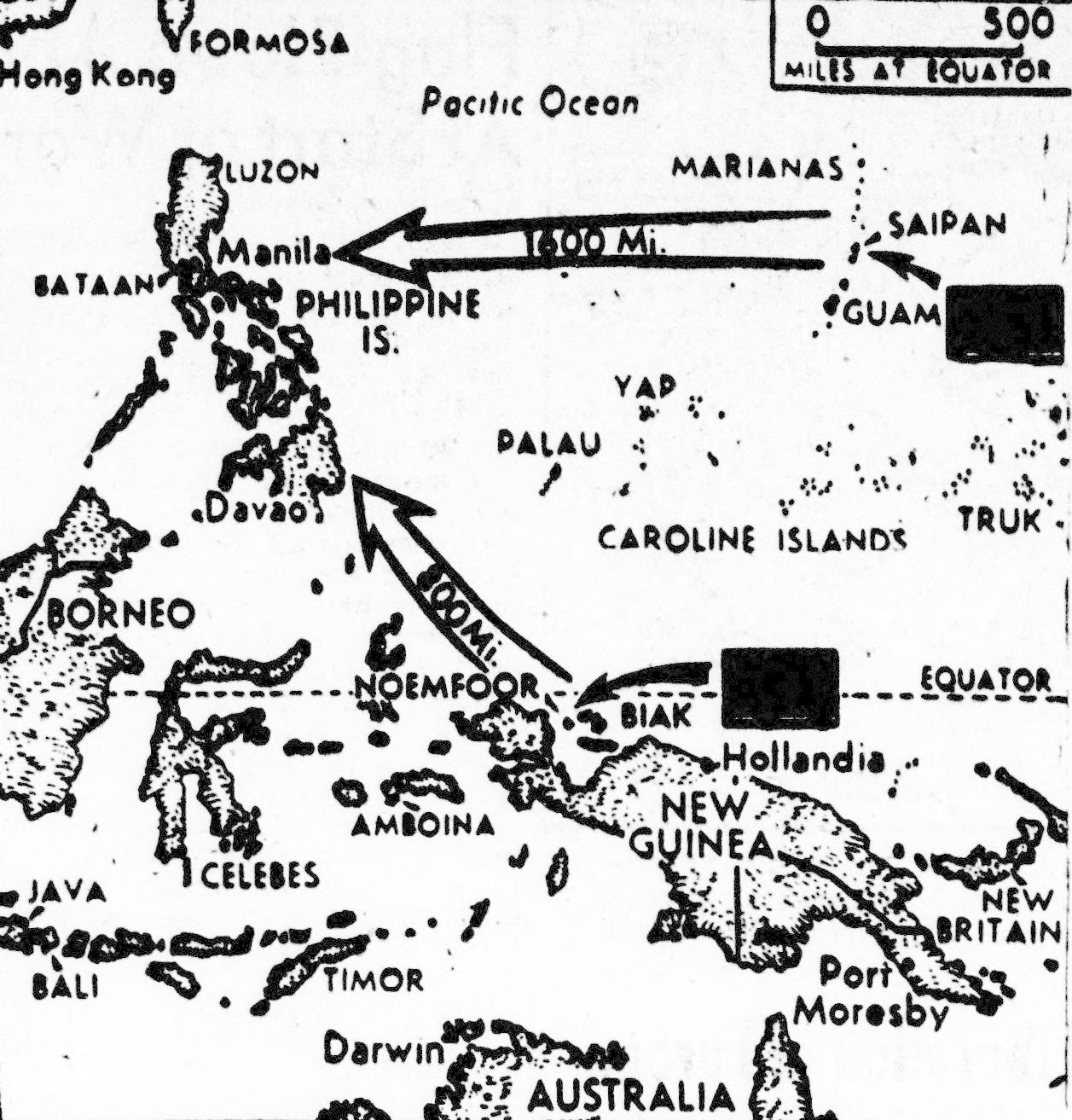The Evening Star (July 4, 1944)
Landing represents 100-mile advance toward Philippines
Double threat to Philippines

Solid arrows point to Noemfoor Island, off New Guinea, and Saipan, in the Marianas, where U.S. troops are fighting for strategic bases. The landing on Noemfoor was announced last night. Open arrows with distance indicators show how these advances form a double threat to the Jap-held Philippines. (AP)
Advanced Allied HQ, New Guinea (AP) –
U.S. troops have invaded Noemfoor Island off Dutch New Guinea and seized its principal airdrome in a 100-mile swoop toward the Philippines.
Headquarters announced today that units of the 6th Army, under Lt. Gen. Walter Krueger, landed on Noemfoor’s western coast at 8:00 a.m. Sunday.
Within two hours, the green-clad infantrymen overcame light enemy opposition and captured Kamiri Airstrip, a 5,000-foot landing field badly cratered by Allied bombs. The troops found 30 Japanese airplanes there, most of them damaged beyond repair.
At last reports, the invaders were pushing toward the island’s two remaining airdromes, one of them three miles away.
Murlin Spencer, Associated Press correspondent, said U.S. casualties were among the smallest suffered in any landing operation in the Southwest Pacific. Only 45 Japanese dead were counted in the first few hours of fighting.
Noemfoor is 1,400 miles southwest of the Marianas, where other U.S. soldiers and two divisions of Marines have taken almost two-thirds of Saipan Island and have killed more than 6,000 Japanese at a cost of more than 2,200 American dead or missing – the heaviest casualties of the Pacific War.
The Americans have surrounded Saipan’s principal city, Garapan, on three sides, and have squeezed the remaining Japanese defenders into the narrow northern end of the island.
There was no Pearl Harbor communiqué for the 24-hour period of July 3, Honolulu Time, indicating that the situation on Saipan had not changed considerably.
Gen, Douglas MacArthur, in an Independence Day communiqué referring to the Noemfoor operation, said:
Our forces landed with practically no loss, either ground, naval or air, and promptly secured the airfield, our main objective, without a struggle.
The seizure of this base will give added breadth and depth to our air deployment and will further dislocate the enemy’s South Seas defenses already seriously shaken by our previous advances.
Noemfoor, 100 miles west of the U.S.-occupied Schouten Islands where two airfields are already in operation, is only 50 miles from Manokwari, strongest remaining Japanese base in Dutch New Guinea. Guarding the entrance to Geelvink Bay, it is closer to the Philippines than either to Darwin, Australia, or Port Moresby, New Guinea. Timor, Celebes, Davao, Yap and Palau are all less than 1,000 miles away.
A dispatch filed yesterday from the flagship said that with the 2nd Marines holding the surrounding hills and advancing steadily in the center and northern part of the city, the fall of Garapan is imminent.
In the face of an American thrust, Japanese troops were declared rapidly abandoning the city and fleeing northward. Thousands of Japanese civilians preceded the troops in flight out of the battered and bombed city which was a mass of ruins.
The 27th Infantry Division pushed forward, bringing itself nearly parallel to more advanced positions of the 4th Marines who have made big strides along the eastern coast.
Gen. MacArthur’s headquarters also announced the capture last Friday of Maffin Bay airdrome on the Dutch New Guinea mainland 250 miles east of Noemfoor. Nearby Wake Island airstrip has been in Allied hands for six weeks. The Japanese still hold Sawar Drome near the Maffin Strip, but Allied planes have denied them the use of it.
New raids on Jap bases
New raids on Manokwari, Timor, Palau, Yap, Wewak, Rabaul, Havieng and other Japanese bases in the Southwest Pacific were listed in Gen. MacArthur’s communiqué.
The Noemfoor landing, Gen. MacArthur said, was made “through narrow, difficult coral reefs generally regarded as impractical for such a purpose. As a result, the attack was completely unexpected by the enemy and his defense preparations were outflanked.”
Cruisers and destroyers under the command of RAdm. William F. Fechteler started shelling Noemfoor’s west coast before dawn. Fighters and bombers of the Far Eastern Air Force joined the pre-invasion attack.
There was some Japanese mortar, and artillery fire at first, and enemy anti-aircraft guns were leveled briefly against the warship. By 10:00 a.m., all enemy mortar and artillery fire had been silenced.
Kamiri Drome had been captured, and the push to the other airfields was on.
